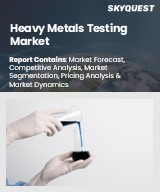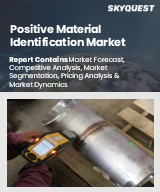
|
시장보고서
상품코드
1623839
형광 분광법 시장 규모, 점유율, 성장 분석, 유형별, 용도별, 지역별 시장 규모, 점유율, 성장 분석 - 산업 예측(2025-2032년)Fluorescence Spectroscopy Market Size, Share, Growth Analysis, By Type (X-Ray Fluorescence Spectrometer, Molecular Fluorescence Spectrometer), By Application, By Region - Industry Forecast 2025-2032 |
||||||
형광 분광법 시장 규모는 2023년 216억 7,000만 달러로 평가되었습니다. 2024년 233억 6,000만 달러에서 2032년 426억 달러에 이르고, 예측 기간(2025-2032년) 동안 7.8%의 연평균 복합 성장률(CAGR)을 나타낼 전망입니다.
형광 분광법은 형광 분자의 측정, 분자간 상호작용 탐색, 생물학적 구조 분석을 위해 생명공학, 제약, 환경과학, 재료과학 등의 분야에서 활용되고 있는 중요한 분석 기술입니다. 생명과학 및 첨단 의료 기술로의 적용 확대로 세계 시장은 크게 확대될 것으로 예상됩니다. 북미는 생명공학 기업 및 제약 기업의 존재감이 강해 시장을 독점할 것으로 예상되며, 아시아태평양은 활발한 연구개발 활동이 성장의 원동력이 되고 있습니다. 시장의 주요 기업들은 연구개발에 많은 투자를 하고 있으며, 전략적 제휴를 통해 제품 혁신과 다각화를 꾀하고 있습니다. 전반적으로 형광 분광법 시장의 성장 궤적은 기술 발전, R&D 노력 증가, 개인 맞춤형 의료에 대한 수요 증가에 의해 뒷받침되고 있습니다.
목차
서론
- 조사 목적
- 조사 범위
- 정의
조사 방법
- 정보 조달
- 2차 데이터와 1차 데이터 방법
- 시장 규모 예측
- 시장 전제조건과 제한
주요 요약
- 세계 시장 전망
- 공급과 수요 동향 분석
- 부문별 기회 분석
시장 역학과 전망
- 시장 개요
- 시장 규모
- 시장 역학
- 성장 촉진요인과 기회
- 성장 억제요인과 과제
- Porter의 Five Forces 분석
주요 시장 인사이트
- 중요 성공 요인
- 경쟁 정도
- 주요 투자 기회
- 시장 생태계
- 시장의 매력 지수(2024년)
- PESTEL 분석
- 거시경제 지표
- 밸류체인 분석
- 가격 분석
- 사례 연구
형광 분광법 시장 규모 : 유형별
- 시장 개요
- X선 형광 분광계
- 분자 형광 분광계
형광 분광법 시장 규모 : 용도별
- 시장 개요
- 의약품에의 응용
- 바이오테크놀러지 및 바이오의약품 응용
- 식품 및 음료 검사
- 환경 테스트
- 학술연구
- 기타 용도
형광 분광법 시장 규모
- 북미
- 미국
- 캐나다
- 유럽
- 독일
- 스페인
- 프랑스
- 영국
- 이탈리아
- 기타 유럽
- 아시아태평양
- 중국
- 인도
- 일본
- 한국
- 기타 아시아태평양
- 라틴아메리카
- 브라질
- 기타 라틴아메리카
- 중동 및 아프리카
- GCC 국가
- 남아프리카공화국
- 기타 중동 및 아프리카
경쟁 정보
- 주요 5개사 비교
- 주요 기업의 시장 포지셔닝(2024년)
- 주요 시장 기업이 채택한 전략
- 시장 최근 동향
- 기업의 시장 점유율 분석(2024년)
- 주요 기업 개요
- 기업 개요
- 제품 포트폴리오 분석
- 부문별 점유율 분석
- 매출 전년대비 비교(2022-2024년)
주요 기업 개요
- HORIBA, Ltd.(Japan)
- Thermo Fisher Scientific Inc.(USA)
- PerkinElmer, Inc.(USA)
- Bruker Corporation(USA)
- Agilent Technologies, Inc.(USA)
- Shimadzu Corporation(Japan)
- JASCO Corporation(Japan)
- Edinburgh Instruments Ltd.(UK)
- Hitachi High-Technologies Corporation(Japan)
- Hamamatsu Photonics K.K.(Japan)
- Stellarnet, Inc.(USA)
- Foss A/S(Denmark)
- Ocean Optics, Inc.(USA)
- PicoQuant GmbH(Germany)
- KNAUER Wissenschaftliche Gerate GmbH(Germany)
- Jenway Limited(UK)
- Bibby Scientific Limited(UK)
- Photon Technology International, Inc.(USA)
- Malvern Panalytical Ltd.(UK)
- Andor Technology Ltd.(UK)
결론과 추천 사항
LSH 25.01.20Fluorescence Spectroscopy Market size was valued at USD 21.67 Billion in 2023 and is poised to grow from USD 23.36 Billion in 2024 to USD 42.6 Billion by 2032, growing at a CAGR of 7.8% during the forecast period (2025-2032).
Fluorescence spectroscopy is a vital analytical technique utilized across biotechnology, pharmaceuticals, environmental science, and materials science to measure fluorescent molecules, explore molecular interactions, and analyze biological structures. The global market is projected for significant expansion, propelled by its increasing applications in life sciences and advanced medical technologies. North America is anticipated to dominate the market due to a robust presence of biotech and pharmaceutical firms, while Asia Pacific's growth is fueled by rising research and development activities. Key market players are heavily investing in R&D, aiming to innovate and diversify their product offerings through strategic collaborations. Overall, the fluorescence spectroscopy market's growth trajectory is supported by technological advancements, heightened R&D endeavors, and escalating demand for personalized medicine.
Top-down and bottom-up approaches were used to estimate and validate the size of the Fluorescence Spectroscopy market and to estimate the size of various other dependent submarkets. The research methodology used to estimate the market size includes the following details: The key players in the market were identified through secondary research, and their market shares in the respective regions were determined through primary and secondary research. This entire procedure includes the study of the annual and financial reports of the top market players and extensive interviews for key insights from industry leaders such as CEOs, VPs, directors, and marketing executives. All percentage shares split, and breakdowns were determined using secondary sources and verified through Primary sources. All possible parameters that affect the markets covered in this research study have been accounted for, viewed in extensive detail, verified through primary research, and analyzed to get the final quantitative and qualitative data.
Fluorescence Spectroscopy Market Segmental Analysis
Global Fluorescence Spectroscopy Market is segmented by type, application and region. Based on type, the market is segmented into x-ray fluorescence spectrometer and molecular fluorescence spectrometer. Based on application, the market is segmented into pharmaceutical applications, biotechnology & biopharmaceutical applications, food & beverage testing, environment testing, academic research and other applications. Based on region, the market is segmented into North America, Europe, Asia Pacific, Latin America and Middle East & Africa.
Driver of the Fluorescence Spectroscopy Market
The fluorescence spectroscopy market is primarily driven by the surge in research and development initiatives across various sectors, particularly in biotechnology, pharmaceuticals, and environmental science. As these fields evolve and the need for novel and groundbreaking products intensifies, the reliance on advanced fluorescence spectroscopy instruments and solutions is anticipated to rise correspondingly. This growing emphasis on innovation not only fuels the demand for effective analytical techniques but also enhances the technology's applications, thereby establishing fluorescence spectroscopy as an indispensable tool in scientific research and industrial processes. Consequently, the market is poised for significant expansion in response to these trends.
Restraints in the Fluorescence Spectroscopy Market
The fluorescence spectroscopy market faces notable restraints, primarily due to the substantial costs associated with both the equipment and its maintenance. These financial burdens can pose significant challenges for small to medium-sized laboratories and research facilities, ultimately hindering their ability to invest in such advanced technology. Consequently, the high expenses may limit accessibility and deter potential users from adopting fluorescence spectroscopy techniques, thereby restricting the overall growth potential of the market. This presents a critical obstacle, as many institutions may prioritize more affordable alternatives, impacting the market's expansion and innovation in the field.
Market Trends of the Fluorescence Spectroscopy Market
The fluorescence spectroscopy market is experiencing a robust upward trend, primarily driven by escalating demand within the healthcare sector. Factors such as the rising prevalence of chronic diseases and the necessity for precise diagnostic techniques are propelling the adoption of fluorescence spectroscopy in drug discovery, clinical diagnostics, and medical research applications. Innovations in technology, combined with a growing emphasis on personalized medicine, are further enhancing its utility in detecting biomolecular interactions and cellular processes. This trend is underscored by continuous investments in research and development, positioning fluorescence spectroscopy as an essential tool in advancing healthcare outcomes and diagnostics efficiency.
Table of Contents
Introduction
- Objectives of the Study
- Scope of the Report
- Definitions
Research Methodology
- Information Procurement
- Secondary & Primary Data Methods
- Market Size Estimation
- Market Assumptions & Limitations
Executive Summary
- Global Market Outlook
- Supply & Demand Trend Analysis
- Segmental Opportunity Analysis
Market Dynamics & Outlook
- Market Overview
- Market Size
- Market Dynamics
- Drivers & Opportunities
- Restraints & Challenges
- Porters Analysis
- Competitive rivalry
- Threat of substitute
- Bargaining power of buyers
- Threat of new entrants
- Bargaining power of suppliers
Key Market Insights
- Key Success Factors
- Degree of Competition
- Top Investment Pockets
- Market Ecosystem
- Market Attractiveness Index, 2024
- PESTEL Analysis
- Macro-Economic Indicators
- Value Chain Analysis
- Pricing Analysis
- Case Studies
Global Fluorescence Spectroscopy Market Size by Type & CAGR (2025-2032)
- Market Overview
- X-Ray Fluorescence Spectrometer
- Molecular Fluorescence Spectrometer
Global Fluorescence Spectroscopy Market Size by Application & CAGR (2025-2032)
- Market Overview
- Pharmaceutical Applications
- Biotechnology & Biopharmaceutical Applications
- Food & Beverage Testing
- Environment Testing
- Academic Research
- Other Applications
Global Fluorescence Spectroscopy Market Size & CAGR (2025-2032)
- North America (Type, Application)
- US
- Canada
- Europe (Type, Application)
- Germany
- Spain
- France
- UK
- Italy
- Rest of Europe
- Asia Pacific (Type, Application)
- China
- India
- Japan
- South Korea
- Rest of Asia-Pacific
- Latin America (Type, Application)
- Brazil
- Rest of Latin America
- Middle East & Africa (Type, Application)
- GCC Countries
- South Africa
- Rest of Middle East & Africa
Competitive Intelligence
- Top 5 Player Comparison
- Market Positioning of Key Players, 2024
- Strategies Adopted by Key Market Players
- Recent Developments in the Market
- Company Market Share Analysis, 2024
- Company Profiles of All Key Players
- Company Details
- Product Portfolio Analysis
- Company's Segmental Share Analysis
- Revenue Y-O-Y Comparison (2022-2024)
Key Company Profiles
- HORIBA, Ltd. (Japan)
- Company Overview
- Business Segment Overview
- Financial Updates
- Key Developments
- Thermo Fisher Scientific Inc. (USA)
- Company Overview
- Business Segment Overview
- Financial Updates
- Key Developments
- PerkinElmer, Inc. (USA)
- Company Overview
- Business Segment Overview
- Financial Updates
- Key Developments
- Bruker Corporation (USA)
- Company Overview
- Business Segment Overview
- Financial Updates
- Key Developments
- Agilent Technologies, Inc. (USA)
- Company Overview
- Business Segment Overview
- Financial Updates
- Key Developments
- Shimadzu Corporation (Japan)
- Company Overview
- Business Segment Overview
- Financial Updates
- Key Developments
- JASCO Corporation (Japan)
- Company Overview
- Business Segment Overview
- Financial Updates
- Key Developments
- Edinburgh Instruments Ltd. (UK)
- Company Overview
- Business Segment Overview
- Financial Updates
- Key Developments
- Hitachi High-Technologies Corporation (Japan)
- Company Overview
- Business Segment Overview
- Financial Updates
- Key Developments
- Hamamatsu Photonics K.K. (Japan)
- Company Overview
- Business Segment Overview
- Financial Updates
- Key Developments
- Stellarnet, Inc. (USA)
- Company Overview
- Business Segment Overview
- Financial Updates
- Key Developments
- Foss A/S (Denmark)
- Company Overview
- Business Segment Overview
- Financial Updates
- Key Developments
- Ocean Optics, Inc. (USA)
- Company Overview
- Business Segment Overview
- Financial Updates
- Key Developments
- PicoQuant GmbH (Germany)
- Company Overview
- Business Segment Overview
- Financial Updates
- Key Developments
- KNAUER Wissenschaftliche Gerate GmbH (Germany)
- Company Overview
- Business Segment Overview
- Financial Updates
- Key Developments
- Jenway Limited (UK)
- Company Overview
- Business Segment Overview
- Financial Updates
- Key Developments
- Bibby Scientific Limited (UK)
- Company Overview
- Business Segment Overview
- Financial Updates
- Key Developments
- Photon Technology International, Inc. (USA)
- Company Overview
- Business Segment Overview
- Financial Updates
- Key Developments
- Malvern Panalytical Ltd. (UK)
- Company Overview
- Business Segment Overview
- Financial Updates
- Key Developments
- Andor Technology Ltd. (UK)
- Company Overview
- Business Segment Overview
- Financial Updates
- Key Developments



















